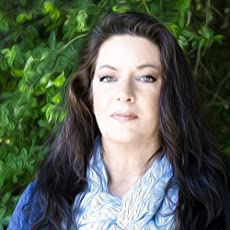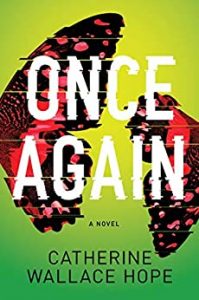Writing Challenges: Part II of III: Time Out of (Your) Mind
 Writing Challenges: Part II of III (read part one HERE)
Writing Challenges: Part II of III (read part one HERE)
Management of time within the long-form narrative is always tricky, and it has continually proved a challenging task for me — and never more so than with my novel Once Again. The story was inspired by a dream I had in which my husband and I had once had a daughter, but she’d been kidnapped. In the dream, I saw that the abduction was happening all over again, and I desperately sought a way to stop it.
After I woke in a heart-thudding panic, I mulled the story over, wondering if I could give it the shape of a suspenseful piece of speculative fiction. My first thought was, “Hmmm. Two timelines — past and present. Should be possible.”
I knew there would be research, which is something I enjoy, and I recognized there was a mythological component that would add another layer. I dove in, expecting to be able to put everything together — having no idea what I was in for. Isn’t that always the case?
The consideration of time’s passage in a narrative requires diligent analysis, which is a concrete job and nothing like the pleasure of allowing the daydreamy bits of cinema to unfold as we make up the story in our minds. In the kind of stories I write, the ticking clock is a primary factor. It’s the overall template of time the story will fill.
It gives justification to the acceleration of pace and dictates the rising levels of urgency. I keep that ticking clock in mind even as I roam around in the first draft. I also like to work within a three-act/four- or five-part structure as I muddle through a second draft, so that contributes to the mathematics too.
Add to that the demands of balance from scene to scene, knowing that greater significance measures fuller length in inches on the page and that the tempo and intensity increase the closer the drama gets to the part’s apex. It’s enough to make a writer’s brain overheat.
I needed to respect the demands for the particular story of Once Again in which related characters exist in separate time periods simultaneously. As I worked to develop each character’s arc, I also incorporated more and more of my research, from which I learned that time, in a quantum sense, is not ordered the way we think it is. It’s not the uniform, constant, simple river we perceive. The characters in the story experience anomalies I extrapolated from the research. Understandings that blew my mind baffled them too. In order to wrangle the chaotic aspects of time in my novel, it helped me initially to think of it as a voyage, and maybe this approach will be helpful for you too.
I tried to think of my story as a ship setting out to travel across the sea from one port to another.The story time equals all of the time between those two ports: calendar time, with one day following the other. And no matter what happens at sea, those days tick off at their designated rate.
The emotional time has a completely different shape. On a day when the water is smooth and the wind is kind, emotional time would collapse and fit into a small space. Imagine a captain’s log reading: “Calm water. Light wind. Crew working to tasks.”
But on a day of disaster, emotional time would elongate. Could the log read: “Storm. Damage. All hope lost”? No. T
he log would include all of the details about the oncoming storm, what the crew did to respond, how the waves swelled and the winds roared. It would show precise times and currents. It would list the safety measures taken for the passengers. And once the storm was over, all the damage would be assessed and recorded.
But no matter how few words it took to acknowledge a calm day and how many more pages it took to display the devastation of the storm, the days of calendar time within each part would have ticked off at their preordained and constant rate. For further explanation of this technique, see the chapter on holy time vs. clock time in Lisa Lenard-Cook’s The Mind of Your Story (Writer’s Digest Books, 2008).
I found it helpful to treat my story’s structure like a voyage until the last drafts. That was when I could translate the fine points into data on a spreadsheet that would allow me to track each character’s knowledge, intentions, and location scene by scene and moment by moment as a time-slip phenomenon unfolded around them. It seemed endless — the rewriting effort required to balance all of the facets of time within the story, from the long sweep across characters’ entire lives together to the syllable-length adjustments at the sentence level, from understanding the overall shape to the part-design effort to build the story with control over
- tempo: the level of activity within a scene
- rhythm: the varying length of scenes within a section
- pace: the speed at which plot points are revealed
- progression: the accumulation of achievements and defeats
The process was difficult and often frustrating, but when it came together, the result was a satisfying realization for me as a writer about how wondrous the human struggle is: the confined, interior struggle to know ourselves set against the expansive, exterior struggle to know where we are in all of the vast reaches of time, to find out what we are capable of when we fight beyond the limits of what we know.
—
Award-winner Catherine Wallace Hope grew up in Colorado, the setting for her thriller Once Again. She earned her degree in creative writing at the University of Colorado. She also delved into dance in New York and art and psychology in California. When she returned to Colorado, she became an instructor at the renowned Lighthouse Writers Workshop, offering creativity workshops for writers. Currently, she and her family are living on an island in the Pacific Northwest where they serve at the pleasure of two astonishingly spoiled dogs.
You can find more at catherinewallacehope.com.
ONCE AGAIN
 An imaginative, emotional debut novel for fans of Ann Patchett about one woman’s fight to save her daughter from repeating a deadly fate.
An imaginative, emotional debut novel for fans of Ann Patchett about one woman’s fight to save her daughter from repeating a deadly fate.
What if you had one chance to save someone you lost?
Isolated in the aftermath of tragedy, Erin Fullarton has felt barely alive since the loss of her young daughter, Korrie. She tries to mark the milestones her therapist suggests–like today, the 500th day without Korrie–but moving through grief is like swimming against a dark current.
Her estranged husband, Zac, a brilliant astrophysicist, seems to be coping better. Lost in his work, he’s perfecting his model of a stunning cosmological phenomenon, one he predicts will occur today–an event so rare, it keeps him from being able to acknowledge Erin’s coinciding milestone.
But when Erin receives a phone call from her daughter’s school, the same call she received five hundred days earlier when Korrie was still alive, Erin realizes something is happening. Or happening again. Struggling to understand the sudden shifts in time, she pieces together that the phenomenon Zac is tracking may have presented her with the gift of a lifetime: the chance to save her daughter.
Unable to reach Zac or convince the authorities of what is happening, Erin is forced to find the answer on her own, Erin must battle to keep the past from repeating–or risk losing her daughter for good.
BUY HERE
Category: How To and Tips























